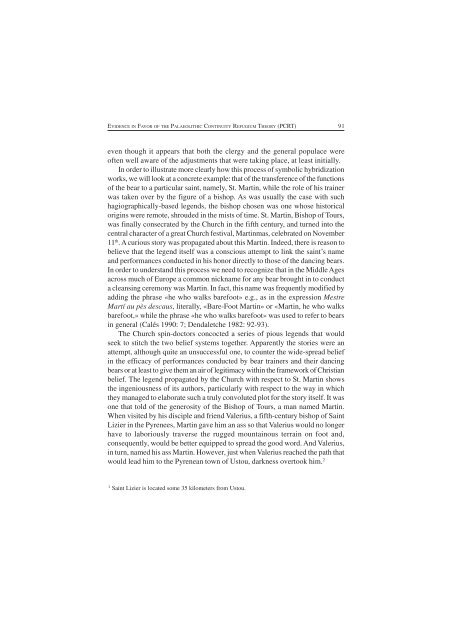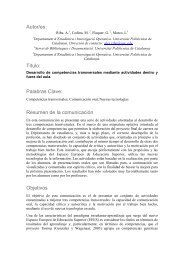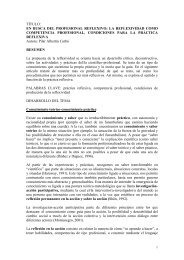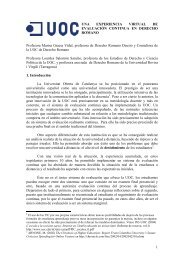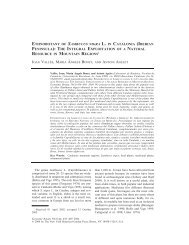Impaginato 5.p65 - Universitat Rovira i Virgili
Impaginato 5.p65 - Universitat Rovira i Virgili
Impaginato 5.p65 - Universitat Rovira i Virgili
You also want an ePaper? Increase the reach of your titles
YUMPU automatically turns print PDFs into web optimized ePapers that Google loves.
EVIDENCE IN FAVOR OF THE PALAEOLITHIC CONTINUITY REFUGIUM THEORY (PCRT)<br />
even though it appears that both the clergy and the general populace were<br />
often well aware of the adjustments that were taking place, at least initially.<br />
In order to illustrate more clearly how this process of symbolic hybridization<br />
works, we will look at a concrete example: that of the transference of the functions<br />
of the bear to a particular saint, namely, St. Martin, while the role of his trainer<br />
was taken over by the figure of a bishop. As was usually the case with such<br />
hagiographically-based legends, the bishop chosen was one whose historical<br />
origins were remote, shrouded in the mists of time. St. Martin, Bishop of Tours,<br />
was finally consecrated by the Church in the fifth century, and turned into the<br />
central character of a great Church festival, Martinmas, celebrated on November<br />
11 th . A curious story was propagated about this Martin. Indeed, there is reason to<br />
believe that the legend itself was a conscious attempt to link the saint’s name<br />
and performances conducted in his honor directly to those of the dancing bears.<br />
In order to understand this process we need to recognize that in the Middle Ages<br />
across much of Europe a common nickname for any bear brought in to conduct<br />
a cleansing ceremony was Martin. In fact, this name was frequently modified by<br />
adding the phrase «he who walks barefoot» e.g., as in the expression Mestre<br />
Martí au pès descaus, literally, «Bare-Foot Martin» or «Martin, he who walks<br />
barefoot,» while the phrase «he who walks barefoot» was used to refer to bears<br />
in general (Calés 1990: 7; Dendaletche 1982: 92-93).<br />
The Church spin-doctors concocted a series of pious legends that would<br />
seek to stitch the two belief systems together. Apparently the stories were an<br />
attempt, although quite an unsuccessful one, to counter the wide-spread belief<br />
in the efficacy of performances conducted by bear trainers and their dancing<br />
bears or at least to give them an air of legitimacy within the framework of Christian<br />
belief. The legend propagated by the Church with respect to St. Martin shows<br />
the ingeniousness of its authors, particularly with respect to the way in which<br />
they managed to elaborate such a truly convoluted plot for the story itself. It was<br />
one that told of the generosity of the Bishop of Tours, a man named Martin.<br />
When visited by his disciple and friend Valerius, a fifth-century bishop of Saint<br />
Lizier in the Pyrenees, Martin gave him an ass so that Valerius would no longer<br />
have to laboriously traverse the rugged mountainous terrain on foot and,<br />
consequently, would be better equipped to spread the good word. And Valerius,<br />
in turn, named his ass Martin. However, just when Valerius reached the path that<br />
would lead him to the Pyrenean town of Ustou, darkness overtook him. 2<br />
2 Saint Lizier is located some 35 kilometers from Ustou.<br />
91


